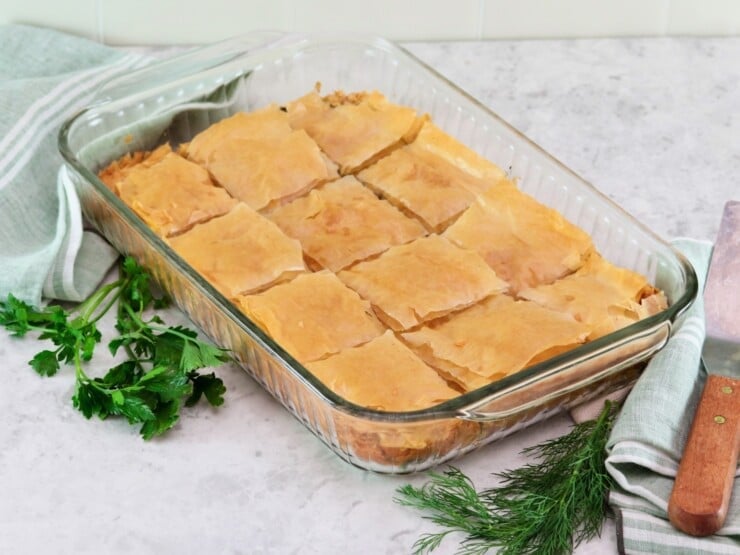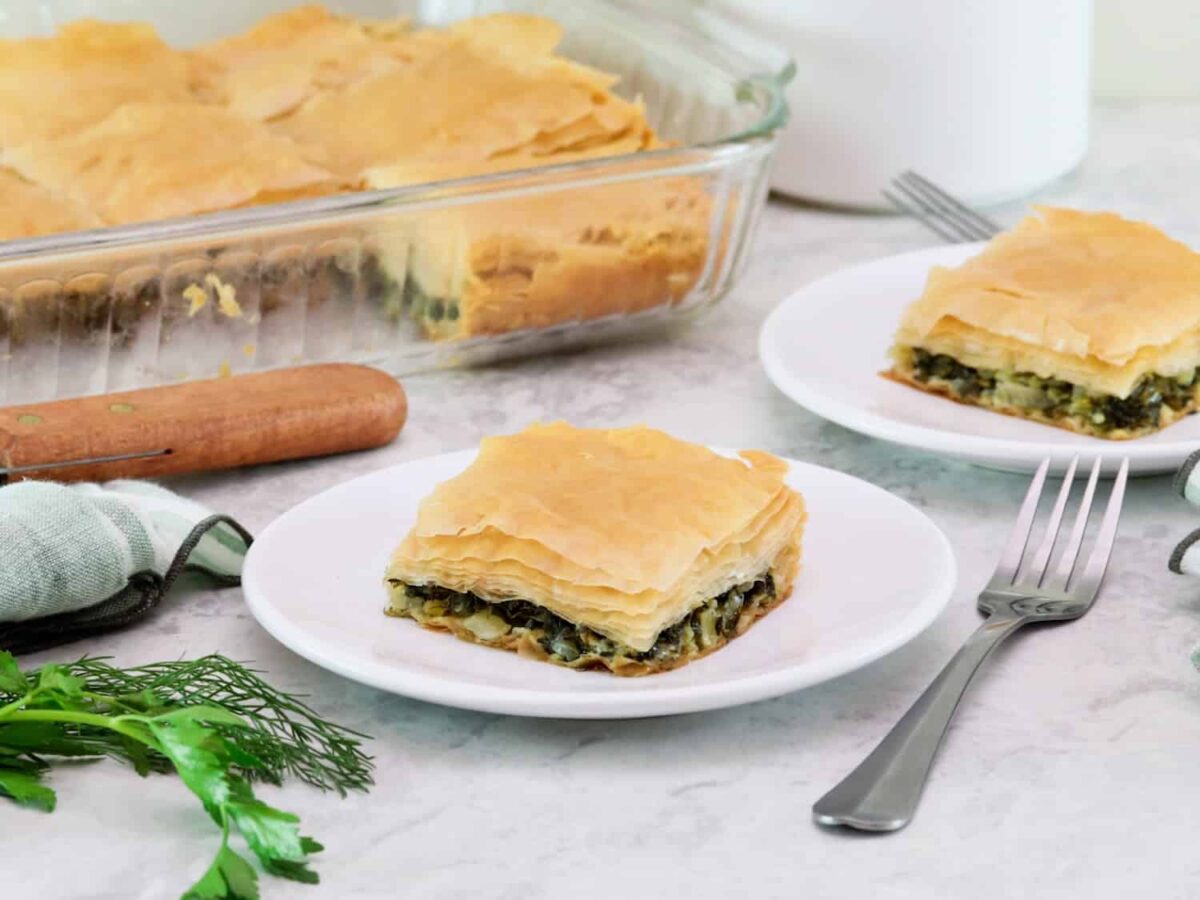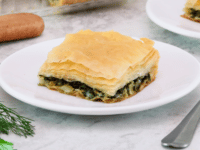Spanakopita is one of my favorite Greek dishes. This Greek spinach pie with layers of crispy phyllo dough is a classic Mediterranean recipe.
In traditional spanakopita, feta cheese is included in the filling. I recently challenged myself to create a vegan spanakopita recipe for people who are avoiding dairy foods or animal products.
Unlike other plant-based spanakopita recipes, I opted not to use a feta substitute like tofu or vegan cheese. Instead, I focused on making a filling of pure greens, flavored with healthy ingredients that capture the salty tang of feta, without the need for cheese.
The result, in my husband’s humble opinion, is every bit as delicious as the original – and he’s a feta cheese fanatic!
What is Spanakopita?
Spanakopita is a Greek spinach pie made with flaky phyllo dough and a savory filling, usually spinach, feta, and herbs. It’s incredibly versatile, served as a main, side, or part of a mezze spread.
In this dairy-free spanakopita, I use simple, wholesome ingredients to create a bold, briny flavor. You can also switch up the greens and herbs for seasonal variations.
Spanakopita can be baked as a large pie or folded into hand-held triangles. Either way, it delivers a crispy, golden crust with a deeply flavorful filling.
History of Spanakopita
Various versions of pita, the Greek word for “pie,” have been enjoyed in Greece for centuries. Spanakopita is thought to have originated in the northern part of Greece. The spinach and feta cheese filling was likely influenced by the Ottoman Empire.
At that time, pies were popular because they traveled well. Additionally, fillings could be made with whatever was available, whether savory or sweet. Crusts were made from a combination of barley, millet, oat, or rye flours.
More modern versions are made with lighter phyllo dough. The word phyllo comes from the Greek word φύλλο (f´yllo), meaning “leaf,” a lovely descriptor of the thin, crispy signature qualities of the dough.
Traditionally, home cooks made spanakopita with whatever greens were freshest and most abundant, including wild greens. However, over time, spinach became the most popular green of choice. But even today, in Greece, you’ll find these types of pies made with whatever greens are growing fresh in the garden. And they are almost always made with homemade phyllo dough, rather than the pre-made dough found in grocery stores.

Recipe Ingredients and Notes
Please be sure to scroll down to the recipe card for the complete details!
- Extra Virgin Olive Oil – This is a staple ingredient in spanakopita, adding omega fats, a rich flavor, and contributing to the crisp, golden crust. Make sure to choose a high-quality olive oil that you enjoy the taste of on its own.
- Herbs and Veggies – Yellow onion, chopped frozen spinach (thaw and drain any excess liquid to prevent a soggy texture), green onions, flat leaf parsley, and fresh dill form the bulk of the filling. Then, I inclue Aleppo pepper for extra depth, adding slightly fruity, smoky notes.
- Pine Nuts – These add richness to the filling.
- Nutritional Yeast – This is my secret to replicating the delicious cheesy flavor classic spanakopita is known for, without the need for dairy.
- Lemon Juice – Freshly squeezed lemon juice is best. The acidity balances some of the richness of the fats, creating a bright, well-rounded taste.
- Coconut Aminos – This adds a salty, briny flavor you get with real cheese. If you don’t need to keep this vegan spanakopita recipe gluten-free, you can substitute soy sauce instead. I recommend using low-sodium varieties so that you have better control over the flavor!
- Cornstarch – A thickener, this helps the filling hold together, though it is still a little crumblier than traditional recipes.
- Phyllo Dough Sheets – I use pre-made frozen phyllo dough (also known as phyllo pastry or filo pastry) to keep this recipe quick and easy. Just make sure to completely thaw and drain it before you begin. Otherwise, your spanakopita is likely to become soggy.
How to Make the Best Vegan Spanakopita Recipe
- Sauté. Heat olive oil in a sauté pan over medium heat, and cook the onion until tender. Then, transfer the onions to a bowl.
- Combine. Add more oil to the onions along with the other filling ingredients, and mix to combine. Set aside to cool.
- Prepare the dough. Lay thawed phyllo sheets on a flat surface, and cover them with a damp tea towel. This keeps it soft and pliable while you work! Trim the dough as needed so it fits into the bottom of an oiled baking dish.
- Layer. Working with one sheet at a time, lay a sheet of phyllo dough in the bottom of an oiled baking dish, letting it come up the sides. Repeat, layering 8 sheets at a time. Brush each sheet with oil, and repeat until you have eight stacked sheets.
- Add the filling. Spread the spinach mixture over the phyllo dough, and repeat, stacking more dough on top for a crust. Then, top the dough with oil to create a crisp, golden crust.
- Bake. Score the top of the crust, and transfer the dish to a preheated oven, baking until the spanakopita is golden brown.
- Serve. Set aside to cool slightly. Then cut and enjoy warm.
Tori’s Tips for Success
- Drain the spinach thoroughly. Make sure to press the thawed spinach firmly in a colander to drain excess moisture and prevent soggy layers.
- Double-check ingredient labels. All of the ingredients in this recipe are naturally vegan, but I recommend double-checking any packaged ingredient labels just to make sure.
- Swap the greens. Replace the spinach with leeks, kale, or wild greens, and vary the herbs to suit your taste preferences.

Vegan Spanakopita
Ingredients
Filling Ingredients
- 3 tablespoons extra virgin olive oil divided
- 1 medium yellow onion finely chopped (1 cup chopped onion)
- 24 ounces frozen chopped spinach thawed and well drained
- 1 bunch green onions chopped
- ½ cup flat leaf parsley chopped
- 1/3 cup fresh dill chopped
- 1/4 cup pine nuts
- 2 garlic cloves minced
- 1 tablespoon nutritional yeast
- 1 tablespoon fresh lemon juice
- 1 teaspoon coconut aminos or soy sauce
- 1 teaspoon cornstarch
- 3/4 teaspoon salt
- ½ teaspoon fresh cracked black pepper
- ¼ teaspoon Aleppo pepper
Crust Ingredients
- 1 package phyllo dough thawed (about 16-20 sheets - you may not need the whole package)
- ½ cup extra virgin olive oil
Instructions
Instructions:
- Defrost your phyllo dough (you may need to start this process a day ahead).Before you start, make sure your thawed spinach is very well drained by pressing it firmly several times in a mesh colander over the sink. Removing excess liquid is key to keeping the pie from becoming soggy.In a sauté pan over medium heat, add 1 tablespoon olive oil. Once hot add onion and cook until tender, about 5-7 minutes.

- Scoop cooked onions into a mixing bowl. Add remaining 2 tablespoons of olive oil, along with all of the remaining filling ingredients, to the bowl. Mix well with a fork or clean hands. Set aside and let cool to room temperature.Preheat the oven to 350 degrees F.

- Lightly brush the inside of a 9X13-inch baking dish with olive oil.Remove phyllo dough from package and lay it gently on a flat surface. Place a clean damp tea towel over the dough, covering it completely. This will keep it soft and pliable for the recipe. If you don’t cover it, the dough will dry out quickly and break easily.If using 13x18 size phyllo sheets, trim 1 1/2 inches from two of the edges (a short edge and a long edge). If using 9x13 size, overlap the pieces as you layer them to make sure you get good coverage on the bottom and sides for the lower crust.

- Lay phyllo one sheet at a time in the pan, covering the bottom of the dish, with dough coming up the sides. Lightly brush each sheet with olive oil. To spread the olive oil evenly, flick the oil lightly with your brush around the sheet, then brush gently to spread (it doesn’t have to fully coat the sheet).

- Once you have stacked 8 sheets, spread filling into the dish over the top of the sheets. Repeat stacking and brushing with the remaining sheets of phyllo and oil, stacking 6-8 sheets on top of the pie. Brush the top liberally with remaining olive oil, using more as needed - having the top well oiled will give it a nice crunch and a golden sheen.

- With a sharp paring knife, trim excess dough off the edges so the pastry is flush with the inside of the pan.

- Use the same knife to score the top layer of phyllo into 12 squares. Be sure not to cut all the way through the bottom crust, or you’ll risk having a soggy pie.

- Bake for 40-50 minutes, or until the top phyllo crust is golden brown. Cool until warm but no longer hot, about 30 minutes. Cut squares along score marks.

- Serve warm. This pie is also great at room temperature. Refrigerate leftovers for up to 4 days. Note that the filling of this dish is a little looser than a traditional spanakopita, so when it cuts some spinach may naturally fall out from between the layers.

NOTES
1/2 teaspoon salt
2 tablespoons vinegar
1/3 cup olive oil, plus more for brushing the phyllo
3 tablespoons vodka (optional)
About 1 cup water, as needed
Cornstarch for rolling the phyllo Place the flour, olive oil and vinegar in the bowl of a standing mixer with dough hooks and pulse a couple of times, then as the mixer runs add slowly water on the side, enough to get a soft dough that is not sticky. Let rest at least 30 minutes before rolling. We usually divide it into 4-5 pieces and work well on the counter each piece, adding a little more flour as needed, to get a soft, silky, and very elastic dough that rolls easily. Then we roll with plenty of CORNSTARCH. In this video, shot some years ago by the Culinary Institute of America, you will see Stamatia, my assistant, who is THE expert in phyllo rolling and has taught me and my husband. I had to work with Stamatia to finally master the technique that very much depends on repetition to make thin and perfect sheets so fast.
Nutrition

tried this recipe?
Let us know in the comments!
If you enjoyed this recipe, I’d love it if you left me a star rating and comment below. Also, don’t forget to share and tag us on Facebook and Instagram!
FAQs
For a balanced plant-based menu, consider pairing this recipe with other delicious vegan dishes such as lentil spinach soup with lemon, chickpea, kale, and fire roasted tomato soup, mnazaleh, or hummus baked vegan moussaka.
Once baked, leftover vegan spanakopita will keep fresh in an airtight container in the fridge for up to 4 days.
You can also freeze unbaked spanakopita for 1-2 months. Just make sure to wrap it tightly to prevent the dough from drying out. Then, thaw it in the fridge overnight, and bake as normal when you’re ready to serve.
Spanakopita is a flavorful and satisfying dish; it’s also very nutritious. This savory pie is packed with nutrients. Spinach is a good source of vitamins C, A, and K, as well as fiber. Spanakopita made with feta has added protein and calcium. The nutritional yeast alternative in this recipe packs a punch of B vitamins.
While this vegan spanakopita lacks added protein, it can be paired with lentil soup or a vegan moussaka to make a more filling meal. This vegan spanakopita pie makes an ideal snack, appetizer, or side dish. Of course, be sure to consult your doctor with any specific questions or concerns.













Looks amazing, I can’t wait to try this as my husband can’t do dairy. Is it okay to leave out the pine nuts though? We have an allergy in the family- if I can’t leave it out is there something I can sub in? Thank you!
Hi Gretchen! The pine nuts add some nice texture, but they aren’t essential. I honestly can’t think of a proper sub for them, so I would just omit them. Enjoy!